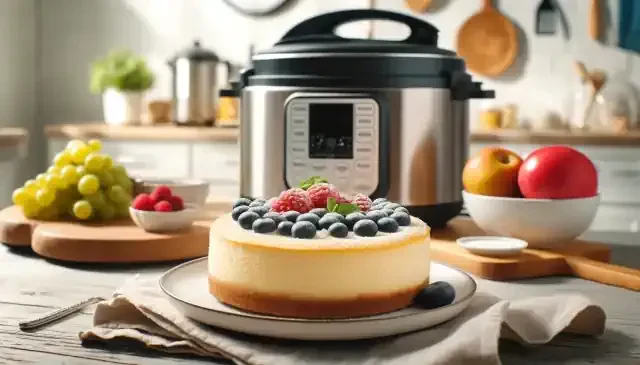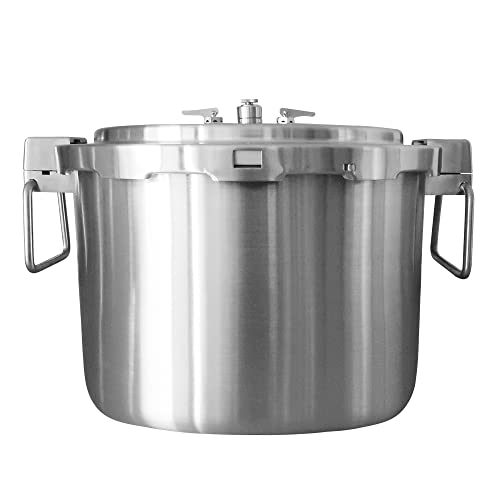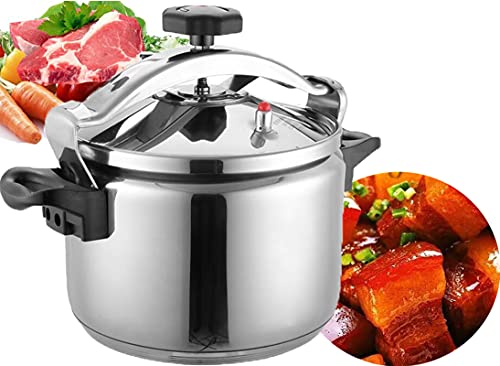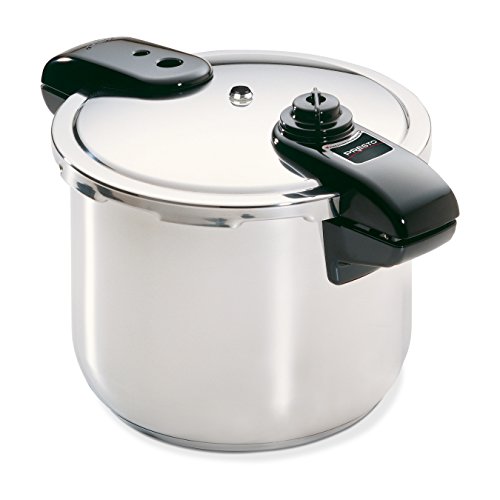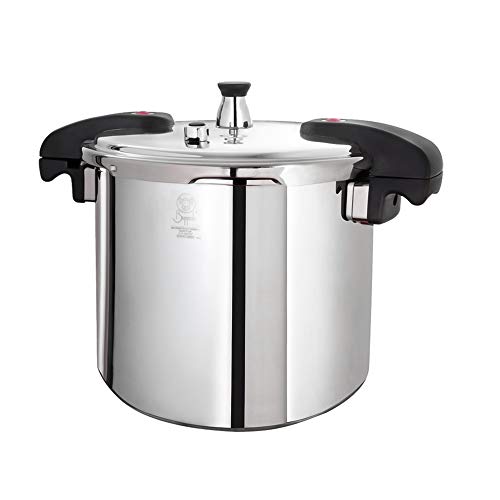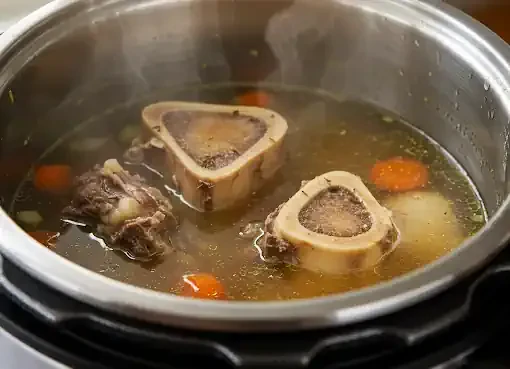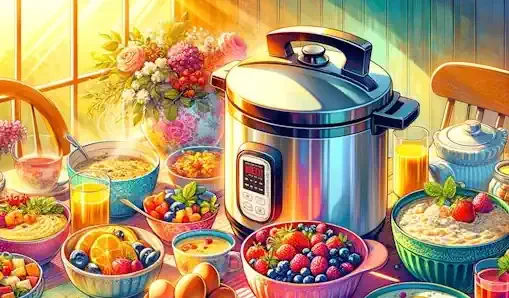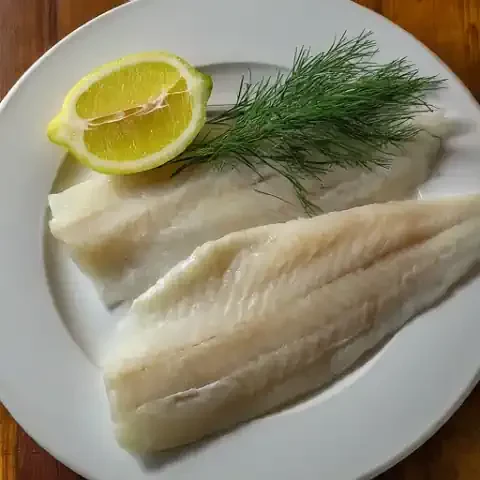Introduction
Setting the Stage
In the bustling world of culinary innovation, the pressure cooker stands as a steadfast ally, not only in savory dishes but also in the realm of desserts. As we embark on this exploration of "Pressure Cooker Perfection: Decadent Desserts," it's essential to understand the transformative power of this humble kitchen appliance.
Traditionally known for its efficiency in reducing cooking times for hearty stews and tender meats, the pressure cooker has quietly emerged as a game-changer in dessert-making circles. Its ability to create moist, flavorful desserts in a fraction of the time required by conventional methods has sparked a revolution in home kitchens worldwide.
Yet, beyond its time-saving capabilities, the pressure cooker offers a level of precision and control that is unparalleled. By harnessing the power of steam under high pressure, it creates an environment conducive to even cooking and thorough flavor infusion. This precision is particularly crucial in dessert-making, where achieving the perfect texture and consistency is paramount.
Importance of Pressure Cooker in Dessert Making
The significance of the pressure cooker in dessert making extends far beyond mere convenience. It represents a convergence of tradition and innovation, where classic recipes are reimagined and boundaries are pushed.
In today's fast-paced world, where time is often a luxury, the pressure cooker empowers even the busiest of individuals to indulge in the pleasures of homemade desserts without sacrificing quality. From rich and creamy cheesecakes to moist and tender puddings, the pressure cooker unlocks a world of possibilities, allowing home cooks to create decadent treats with ease.
Moreover, the pressure cooker's ability to retain moisture and intensify flavors sets it apart as a tool for culinary experimentation. By harnessing the principles of pressure cooking, cooks can achieve results that would otherwise be unattainable, whether it's infusing desserts with bold spices or coaxing out the natural sweetness of seasonal fruits.
In the following sections, we will delve deeper into the nuances of pressure cooker dessert-making, exploring everything from key ingredients and cooking techniques to troubleshooting tips and presentation suggestions. So, let us embark on this journey together, as we unlock the secrets to achieving dessert perfection with the help of our trusty pressure cooker.
Exploring the World of Pressure Cooker Dessert
Brief History
To truly appreciate the significance of pressure cooker desserts, it's essential to take a step back and examine the evolution of this kitchen marvel. While pressure cooking itself dates back centuries, it wasn't until the 20th century that it became a staple in households around the world.
Invented by French physicist Denis Papin in the 17th century, the pressure cooker was initially conceived as a means of tenderizing tough cuts of meat through the application of steam pressure. However, it wasn't until the invention of the modern pressure cooker in the early 1900s that its potential in dessert-making began to be realized.
Over the years, pressure cooker technology has continued to evolve, with advancements in design and functionality making it more accessible and user-friendly. Today, pressure cookers come in a variety of shapes and sizes, from stovetop models to electric multicookers, each offering its own set of advantages and capabilities.
Advantages Over Traditional Methods
What sets pressure cooker desserts apart from their conventionally-made counterparts is not just their efficiency but also their superior flavor and texture. Unlike baking or stovetop cooking, which can often result in uneven heat distribution and inconsistent results, pressure cooking creates a sealed environment where temperatures are carefully regulated, ensuring even cooking and thorough flavor infusion.
Furthermore, the high pressure and steam generated inside the pressure cooker help to break down tough fibers and proteins, resulting in desserts that are incredibly moist and tender. This is particularly beneficial when working with ingredients such as dried fruits and nuts, which can often become tough or chewy when baked or simmered for extended periods.
In addition to its culinary advantages, the pressure cooker also offers environmental benefits, consuming less energy and producing fewer greenhouse gas emissions compared to traditional cooking methods. This makes it not only a practical choice for busy home cooks but also a sustainable one.
As we continue our exploration of pressure cooker desserts, we will delve deeper into the techniques and recipes that make this innovative cooking method so uniquely rewarding. So, join us as we journey further into the world of pressure cooker perfection, where every dessert is a masterpiece waiting to be discovered.
Key Ingredients for Success
Essentials in Pantry
Building a well-stocked pantry is the first step towards successful pressure cooker dessert-making. While the specific ingredients may vary depending on the recipes you intend to explore, there are certain staples that no dessert enthusiast should be without.
Flour: Whether you're whipping up a batch of homemade cookies or a towering layer cake, flour is a fundamental ingredient in many desserts. Opt for all-purpose flour for versatility or experiment with specialty flours like almond or coconut for added flavor and texture.
Sugar: From granulated to powdered to brown, sugar is a sweet necessity in most dessert recipes. It not only adds sweetness but also contributes to texture and browning, making it a crucial component in everything from cakes and cookies to custards and sauces.
Eggs: Eggs play multiple roles in dessert-making, acting as binders, leaveners, and emulsifiers. Whether you're whipping up a fluffy meringue or a rich custard, having a few eggs on hand is essential for achieving the desired consistency and structure.
Dairy: Butter, milk, and cream are all essential ingredients in many classic desserts, lending richness, moisture, and flavor. For dairy-free alternatives, consider options like coconut milk or almond milk, which can impart a unique taste and texture to your creations.
Leavening Agents: Baking powder and baking soda are essential leavening agents that help desserts rise and achieve a light, airy texture. Make sure to check expiration dates regularly, as these ingredients can lose their potency over time.
Specialty Items Worth Investing In
While a well-stocked pantry will cover the basics, there are certain specialty items that can elevate your pressure cooker desserts to the next level. Investing in high-quality ingredients and equipment can make all the difference in achieving professional-level results.
Vanilla Extract: Pure vanilla extract adds a depth of flavor and aroma to desserts that imitation extracts simply can't match. While it may be pricier than its artificial counterparts, a little goes a long way, making it a worthwhile investment for any dessert enthusiast.
Chocolate: Whether you prefer dark, milk, or white, chocolate is a versatile ingredient that can be used in a wide range of desserts, from cakes and brownies to truffles and ganache. Opt for high-quality chocolate with a high cocoa content for the best flavor and texture.
Nuts and Dried Fruits: Nuts and dried fruits add texture, flavor, and nutritional value to desserts, making them a worthwhile addition to your pantry. Stock up on a variety of nuts and dried fruits, such as almonds, walnuts, raisins, and apricots, to use in everything from cookies and bars to cakes and puddings.
Flavor Extracts and Essences: In addition to vanilla extract, consider stocking your pantry with other flavor extracts and essences, such as almond, lemon, and peppermint. These concentrated flavorings can add depth and complexity to your desserts without the need for extra ingredients.
By ensuring that your pantry is stocked with these key ingredients, you'll be well-equipped to tackle any pressure cooker dessert recipe that comes your way. So gather your supplies, roll up your sleeves, and get ready to embark on a delicious culinary adventure unlike any other.
Mastering the Art of Timing: Cooking Techniques
Understanding Cooking Times
One of the most critical aspects of pressure cooker dessert-making is mastering the art of timing. Unlike traditional cooking methods, where recipes often specify precise cooking times, pressure cooking relies on a combination of time, pressure, and temperature to achieve optimal results.
Adjusting Cooking Times: It's essential to follow the recommended cooking times provided in your pressure cooker recipe. However, keep in mind that these times may vary depending on factors such as altitude, ingredient density, and the size of your pressure cooker. Be prepared to adjust cooking times accordingly to ensure that your desserts are cooked through evenly.
Natural Release vs. Quick Release: When pressure cooking desserts, you'll typically have the option of using either a natural release or a quick release method to depressurize the cooker. Natural release involves allowing the pressure to decrease naturally over time, while quick release involves manually releasing the pressure using the pressure release valve. The method you choose will depend on the recipe and the desired texture of your dessert.
Adjusting for Altitude and Pressure Variations
Altitude and pressure variations can have a significant impact on the cooking time and performance of your pressure cooker. As altitude increases, atmospheric pressure decreases, which can affect the boiling point of water and the cooking times of your desserts.
Understanding Altitude Adjustments: If you live at a high altitude, you may need to adjust the cooking times specified in your pressure cooker recipes to account for the lower atmospheric pressure. As a general rule of thumb, for every 1,000 feet above sea level, you may need to increase cooking times by 5-10%.
Testing for Doneness: To ensure that your desserts are cooked through properly, it's essential to test for doneness using a toothpick, cake tester, or instant-read thermometer. Insert the tester into the center of the dessert, and if it comes out clean or registers the correct temperature, your dessert is ready to be removed from the pressure cooker.
By mastering the art of timing and understanding how altitude and pressure variations can affect your cooking, you'll be well-equipped to achieve perfect results with every pressure cooker dessert you make. So don't be afraid to experiment, adjust, and refine your techniques as you explore the world of pressure cooker perfection.
Decadent Delights: Recipes for Sweet Tooths
Classic Favorites Reinvented
One of the joys of pressure cooker dessert-making is the opportunity to reinvent classic favorites with a modern twist. From rich and creamy cheesecakes to indulgent chocolate lava cakes, pressure cooker desserts offer a fresh take on beloved classics that is sure to delight even the most discerning sweet tooth.
Cheesecakes: Traditional cheesecakes can be time-consuming and finicky to prepare, but with a pressure cooker, you can achieve the same creamy texture and rich flavor in a fraction of the time. Experiment with different flavor variations, such as lemon, raspberry, or salted caramel, to create a cheesecake that's uniquely your own.
Pressure Cooker Classic Cheesecake
Ingredients:
For the crust:
1 1/2 cups graham cracker crumbs
1/4 cup granulated sugar
1/2 cup unsalted butter, melted
For the filling:
24 oz (680g) cream cheese, softened
3/4 cup granulated sugar
3 large eggs, at room temperature
1/4 cup sour cream
1/4 cup heavy cream
1 tablespoon all-purpose flour
1 teaspoon vanilla extract
Zest of 1 lemon (optional)
For topping (optional):
Fresh berries
Whipped cream
Instructions:
Prepare the Crust:
In a mixing bowl, combine graham cracker crumbs, sugar, and melted butter. Stir until the mixture resembles wet sand.
Press the mixture evenly onto the bottom of a 7-inch springform pan lined with parchment paper. Use the back of a spoon or a flat-bottomed glass to press it firmly.
Place the pan in the freezer while you prepare the filling.
Prepare the Filling:
In a large mixing bowl, beat the softened cream cheese until smooth and creamy.
Add the sugar and beat until well combined.
Add the eggs, one at a time, mixing well after each addition.
Mix in the sour cream, heavy cream, flour, vanilla extract, and lemon zest (if using) until the filling is smooth and creamy. Be careful not to overmix.
Assemble and Cook:
Pour the filling over the chilled crust in the springform pan.
Tap the pan gently on the countertop to release any air bubbles.
Cover the springform pan tightly with aluminum foil.
Pour 1 cup of water into the inner pot of your pressure cooker and place a trivet or steamer basket inside.
Carefully lower the springform pan onto the trivet or steamer basket.
Close and lock the lid of the pressure cooker.
Cook on high pressure for 35 minutes.
Allow natural pressure release for 10 minutes, then release any remaining pressure manually.
Carefully remove the cheesecake from the pressure cooker using tongs or oven mitts.
Chill and Serve:
Remove the aluminum foil and let the cheesecake cool to room temperature on a wire rack.
Once cooled, refrigerate the cheesecake for at least 4 hours or overnight to set.
Before serving, carefully remove the cheesecake from the springform pan and transfer it to a serving platter.
Top with fresh berries or whipped cream if desired.
Slice and serve chilled. Enjoy your delicious pressure cooker classic cheesecake!
Chocolate Lava Cakes: Few desserts are as decadent and irresistible as a warm, gooey chocolate lava cake. With a pressure cooker, you can achieve the perfect balance of cakey exterior and molten chocolate center in just minutes. Serve with a scoop of vanilla ice cream for an extra indulgent treat.
Pressure Cooker Chocolate Lava Cakes
Ingredients:
4 ounces (115g) semi-sweet or bittersweet chocolate, chopped
1/2 cup (115g) unsalted butter
2 large eggs
2 large egg yolks
1/4 cup (50g) granulated sugar
1 teaspoon vanilla extract
1/4 cup (30g) all-purpose flour
Pinch of salt
Cooking spray or additional butter for greasing ramekins
Powdered sugar, for dusting (optional)
Vanilla ice cream or whipped cream, for serving (optional)
Instructions:
Prepare the Chocolate Mixture:
In a heatproof bowl, combine the chopped chocolate and unsalted butter.
Melt the chocolate and butter together using a double boiler or microwave, stirring until smooth. Set aside to cool slightly.
Prepare the Batter:
In a separate mixing bowl, whisk together the eggs, egg yolks, granulated sugar, and vanilla extract until well combined.
Gradually pour the melted chocolate mixture into the egg mixture, whisking constantly until smooth and glossy.
Add the all-purpose flour and a pinch of salt to the chocolate mixture, and gently fold until just combined. Be careful not to overmix.
Grease Ramekins:
Lightly grease four 6-ounce ramekins with cooking spray or butter. This will prevent the lava cakes from sticking to the ramekins after cooking.
Fill Ramekins:
Divide the chocolate batter evenly among the greased ramekins, filling each one about three-quarters full.
Cook in Pressure Cooker:
Pour 1 cup of water into the inner pot of your pressure cooker.
Place a trivet or steamer basket in the inner pot.
Carefully arrange the filled ramekins on top of the trivet or steamer basket.
Close and lock the lid of the pressure cooker.
Cook on high pressure for 7 minutes.
Release Pressure and Serve:
Once the cooking time is complete, allow the pressure to release naturally for 5 minutes, then perform a quick pressure release.
Carefully remove the ramekins from the pressure cooker using tongs or oven mitts.
Let the lava cakes cool in the ramekins for a few minutes before serving.
Optional: Dust the tops of the lava cakes with powdered sugar before serving.
Serve the chocolate lava cakes warm with a scoop of vanilla ice cream or a dollop of whipped cream on top.
Enjoy the rich, molten chocolate center oozing out of these delightful pressure cooker chocolate lava cakes!
Creative Concoctions for Adventurous Palates
In addition to reinventing classic favorites, pressure cooker desserts also offer the opportunity to get creative and experiment with unique flavor combinations and ingredients. Whether you're a fan of tropical fruits, aromatic spices, or exotic herbs, the possibilities are endless when it comes to pressure cooker dessert-making.
Coconut Mango Rice Pudding: Transport your taste buds to the tropics with this creamy and aromatic coconut mango rice pudding. Made with coconut milk, ripe mangoes, and fragrant jasmine rice, this dessert is a delightful combination of sweet and tropical flavors that is sure to satisfy your cravings.
Pressure Cooker Coconut Mango Rice Pudding
Ingredients:
1 cup arborio rice
1 can (13.5 oz / 400ml) coconut milk
2 cups water
1/2 cup granulated sugar
1/4 teaspoon salt
1 ripe mango, peeled and diced
1/2 teaspoon vanilla extract
1/4 teaspoon ground cardamom (optional)
Shredded coconut, for garnish (optional)
Fresh mint leaves, for garnish (optional)
Instructions:
Combine Ingredients in Pressure Cooker:
In the inner pot of your pressure cooker, combine the arborio rice, coconut milk, water, granulated sugar, and salt. Stir well to combine.
Pressure Cook:
Close the lid of the pressure cooker and make sure the pressure release valve is set to the sealing position.
Cook on high pressure for 10 minutes.
Natural Release and Open Lid:
Once the cooking time is complete, allow the pressure to release naturally for 10 minutes.
After 10 minutes, carefully release any remaining pressure by turning the pressure release valve to the venting position.
Once the pressure has been released and the float valve drops, carefully open the lid of the pressure cooker.
Stir in Mango and Flavorings:
Stir in the diced mango, vanilla extract, and ground cardamom (if using) into the rice pudding mixture until well combined.
Serve and Garnish:
Serve the coconut mango rice pudding warm or chilled, garnished with shredded coconut and fresh mint leaves, if desired.
Enjoy the creamy and flavorful combination of coconut, mango, and rice in this delightful pressure cooker dessert!
This coconut mango rice pudding is perfect for enjoying as a comforting dessert or even as a special breakfast treat. Its tropical flavors and creamy texture make it a delightful dish for any occasion.
Cardamom Pistachio Cake: Add a touch of Middle Eastern flair to your dessert repertoire with this fragrant and flavorful cardamom pistachio cake. Made with ground cardamom, chopped pistachios, and a hint of rose water, this moist and aromatic cake is a delightful treat for any occasion.
Pressure Cooker Cardamom Pistachio Cake
Ingredients:
1 cup all-purpose flour
1/2 cup shelled pistachios, finely ground
1 teaspoon baking powder
1/2 teaspoon baking soda
1/4 teaspoon salt
1/2 teaspoon ground cardamom
1/2 cup unsalted butter, softened
3/4 cup granulated sugar
2 large eggs, at room temperature
1 teaspoon vanilla extract
1/2 cup plain yogurt
1/4 cup milk
Green food coloring (optional)
Pistachios, chopped (for garnish)
Instructions:
Prepare the Cake Batter:
In a mixing bowl, combine the all-purpose flour, ground pistachios, baking powder, baking soda, salt, and ground cardamom. Stir until well combined.
Cream Butter and Sugar:
In a separate mixing bowl, cream together the softened butter and granulated sugar until light and fluffy.
Add Eggs and Vanilla:
Add the eggs, one at a time, to the creamed butter and sugar mixture, beating well after each addition.
Stir in the vanilla extract.
Alternate Wet and Dry Ingredients:
Gradually add the dry flour mixture to the wet ingredients, alternating with the plain yogurt and milk. Mix until just combined.
If desired, add a few drops of green food coloring to achieve a pistachio-green color for the cake batter. Mix until evenly distributed.
Prepare the Pressure Cooker:
Grease a 7-inch round cake pan and line the bottom with parchment paper.
Pour the cake batter into the prepared cake pan and smooth the top with a spatula.
Cook in Pressure Cooker:
Pour 1 cup of water into the inner pot of your pressure cooker.
Place a trivet or steamer basket in the inner pot.
Carefully lower the filled cake pan onto the trivet or steamer basket.
Close and lock the lid of the pressure cooker.
Cook on high pressure for 30-35 minutes.
Release Pressure and Cool:
Once the cooking time is complete, allow the pressure to release naturally for 10 minutes, then perform a quick pressure release.
Carefully remove the cake pan from the pressure cooker using tongs or oven mitts.
Let the cake cool in the pan for 10-15 minutes, then transfer it to a wire rack to cool completely.
Garnish and Serve:
Once the cake has cooled completely, garnish with chopped pistachios on top.
Slice and serve the cardamom pistachio cake on its own or with a dollop of whipped cream or vanilla ice cream, if desired.
Enjoy the fragrant aroma and delicate flavor of this delightful pressure cooker dessert!
Whether you're craving a classic favorite or looking to experiment with new flavors and ingredients, pressure cooker desserts offer endless possibilities for indulgence and creativity. So roll up your sleeves, gather your ingredients, and get ready to embark on a delicious culinary adventure unlike any other.
Tips and Tricks for Flavorful Finishes
Garnishing Like a Pro
The art of garnishing is often overlooked in dessert-making, but it can make a significant difference in the presentation and flavor of your creations. Whether it's a simple dusting of powdered sugar or an elaborate fruit arrangement, the right garnish can elevate your desserts from ordinary to extraordinary.
Fresh Fruit: Fresh fruit is not only a beautiful and colorful garnish but also adds a burst of freshness and acidity to balance out rich and sweet desserts. Consider using seasonal fruits like berries, citrus, or stone fruits to complement your pressure cooker creations.
Whipped Cream: A dollop of freshly whipped cream is a classic and versatile garnish that pairs well with a wide range of desserts, from cakes and pies to puddings and cobblers. For an extra indulgent touch, flavor your whipped cream with vanilla extract, cocoa powder, or liqueurs.
Enhancing Flavors with Unexpected Ingredients
In addition to traditional garnishes, consider incorporating unexpected ingredients and flavorings into your pressure cooker desserts to add depth and complexity. From spices and herbs to alcohol and extracts, these unexpected additions can take your desserts to the next level.
Spices and Herbs: Spices and herbs are an easy and effective way to add depth and complexity to your desserts. Experiment with warming spices like cinnamon, nutmeg, and ginger, or aromatic herbs like lavender, rosemary, and thyme to impart unique flavors and aromas to your pressure cooker creations.
Alcohol and Extracts: Alcohol and extracts are another way to infuse your desserts with bold and complex flavors. Whether it's a splash of rum in your chocolate cake batter or a few drops of almond extract in your cheesecake filling, these ingredients can add depth and richness to your pressure cooker desserts.
By paying attention to the details and incorporating thoughtful garnishes and flavorings into your pressure cooker desserts, you can take your creations from ordinary to extraordinary. So don't be afraid to get creative and experiment with different ingredients and techniques to make your desserts truly unforgettable.
Embracing Versatility: Adapting Recipes to Your Taste
Customizing Flavor Profiles
One of the greatest advantages of pressure cooker dessert-making is its versatility, allowing you to customize recipes to suit your taste preferences and dietary needs. Whether you're looking to reduce sugar, swap out ingredients, or experiment with different flavor combinations, the pressure cooker offers endless opportunities for culinary creativity.
Reducing Sugar: Many dessert recipes can be adapted to reduce the amount of sugar without sacrificing flavor or sweetness. Experiment with using alternative sweeteners like honey, maple syrup, or stevia, or try reducing the amount of sugar called for in the recipe by half and adjusting to taste.
Swapping Ingredients: Don't be afraid to experiment with swapping out ingredients to suit your dietary preferences or accommodate food allergies and sensitivities. For example, you can use gluten-free flour in place of regular flour, coconut milk in place of dairy milk, or applesauce in place of eggs for a vegan-friendly option.
Catering to Dietary Restrictions
In addition to customizing flavor profiles, the pressure cooker also offers a convenient way to cater to various dietary restrictions and preferences. Whether you're cooking for someone with food allergies, sensitivities, or dietary restrictions, there are plenty of pressure cooker dessert recipes that can be adapted to suit their needs.
Gluten-Free: Many pressure cooker dessert recipes can be easily made gluten-free by using gluten-free flour or alternative grains like almond flour, coconut flour, or oat flour. Look for recipes that are naturally gluten-free or can be easily adapted with simple ingredient substitutions.
Dairy-Free: For those with dairy allergies or sensitivities, there are plenty of dairy-free dessert options that can be made in the pressure cooker. Experiment with using coconut milk, almond milk, or other non-dairy alternatives in place of regular milk or cream to create creamy and indulgent desserts without the dairy.
By embracing the versatility of the pressure cooker and adapting recipes to your taste preferences and dietary needs, you can enjoy delicious and satisfying desserts that are tailored to suit your unique palate. So don't be afraid to get creative and experiment with different ingredients and techniques to make pressure cooker dessert-making truly your own.
Troubleshooting: Common Mistakes and Solutions
Addressing Burnt Bottoms and Other Cooking Mishaps
Even the most seasoned cooks encounter mishaps in the kitchen, and pressure cooker dessert-making is no exception. From burnt bottoms to collapsed cakes, there are a variety of common issues that can arise when using a pressure cooker. Fortunately, with a little know-how and some quick thinking, many of these problems can be easily remedied.
Burnt Bottoms: One of the most common issues when pressure cooking desserts is burnt bottoms, which can occur when the dessert comes into direct contact with the bottom of the pressure cooker insert. To prevent this, try placing a trivet or steamer basket in the bottom of the insert to elevate the dessert slightly above the heat source.
Collapsed Cakes: Another common issue with pressure cooker desserts is collapsed cakes, which can occur when the cake is undercooked or the pressure is released too quickly. To prevent this, make sure to cook the cake for the recommended amount of time and allow it to naturally release pressure for at least 5-10 minutes before using the quick release method.
Salvaging Overcooked Desserts
Despite your best efforts, there may be times when your pressure cooker dessert ends up overcooked or otherwise less than perfect. Fortunately, there are a few tricks you can use to salvage overcooked desserts and turn them into delicious treats.
Moisture Boost: If your dessert is dry or overcooked, try adding a drizzle of syrup, caramel sauce, or fruit compote to moisten it up and add flavor. Alternatively, you can brush the dessert with a flavored simple syrup or soak it in a flavored liqueur to add moisture and enhance the taste.
Creative Presentation: Sometimes, a little creativity is all it takes to turn a disappointing dessert into a showstopper. Experiment with different plating techniques, garnishes, and accompaniments to disguise any imperfections and elevate the overall presentation of your dessert.
By familiarizing yourself with common pressure cooker dessert pitfalls and learning how to troubleshoot them effectively, you'll be better equipped to achieve perfect results every time. So don't be discouraged by the occasional mishap—instead, use it as an opportunity to learn and improve your skills in the kitchen.
Presenting Your Masterpieces: Serving and Plating Suggestions
Elevating Presentation
The presentation of a dessert is just as important as its taste, as it is often the first thing that catches the eye and sets the stage for the dining experience. With a few simple techniques and thoughtful touches, you can elevate the presentation of your pressure cooker desserts and turn them into works of art.
Plating Techniques: Experiment with different plating techniques to create visually stunning presentations that showcase your desserts in the best possible light. Whether you opt for a minimalist approach or a more elaborate arrangement, pay attention to factors like color contrast, texture, and balance to create visually appealing compositions.
Garnishes and Decorations: Garnishes and decorations can add a finishing touch to your desserts, enhancing their visual appeal and providing a hint of flavor and texture. Consider using edible flowers, fresh herbs, or finely grated chocolate to add a pop of color and interest to your desserts.
Pairing with Complementary Beverages
To truly elevate the dining experience, consider pairing your pressure cooker desserts with complementary beverages that enhance their flavors and provide a refreshing contrast. Whether you prefer wine, coffee, tea, or spirits, there are plenty of options to choose from that will complement your dessert selection.
Wine Pairings: Wine can be a delightful accompaniment to many pressure cooker desserts, providing a harmonious balance of sweetness, acidity, and tannins. Experiment with different wine varietals, such as riesling, moscato, or port, to find the perfect pairing for your dessert.
Coffee and Tea Pairings: For a more casual or afternoon affair, consider pairing your pressure cooker desserts with coffee or tea. Match the intensity and flavor profile of your dessert with complementary coffee or tea varieties, such as espresso with chocolate desserts or green tea with fruit-based desserts.
By paying attention to the presentation of your pressure cooker desserts and selecting complementary beverages to accompany them, you can create a dining experience that is as visually stunning as it is delicious. So take the time to plate your desserts thoughtfully and consider the beverage pairings carefully to ensure that every aspect of the meal is a feast for the senses.
Conclusion: Elevating Dessert Making with Pressure Cooker Magic
Reflecting on the Journey
As we come to the end of our exploration into the world of pressure cooker desserts, it's worth taking a moment to reflect on the journey we've undertaken. From the humble beginnings of pressure cooking to the innovative techniques and creative recipes we've discovered along the way, it's clear that the pressure cooker has transformed the way we approach dessert-making.
Innovation and Adaptation: Throughout history, cooks and chefs alike have embraced innovation and adaptation as essential tools in the kitchen. The pressure cooker is no exception, offering a versatile and efficient means of creating delicious desserts that are both satisfying and surprising.
Unleashing Creativity: Perhaps most importantly, the pressure cooker has unleashed a wave of creativity and experimentation in the kitchen, empowering home cooks and professional chefs alike to push the boundaries of what is possible in dessert-making. From classic favorites reinvented to bold flavor combinations and unexpected ingredient pairings, the possibilities are truly endless when it comes to pressure cooker desserts.
Encouragement to Experiment and Enjoy
As we bid farewell to our journey through the world of pressure cooker desserts, I encourage you to continue experimenting, exploring, and enjoying the endless possibilities that this innovative cooking method has to offer. Whether you're a seasoned pro or a novice cook, there's always something new to discover and delight in when it comes to pressure cooker dessert-making.
Embracing the Process: Remember that cooking, like any creative endeavor, is as much about the process as it is about the end result. So don't be afraid to embrace the journey, make mistakes, and learn from them along the way. After all, it's the joy of discovery and the satisfaction of creation that make the culinary arts so rewarding.
Sharing the Love: Finally, don't forget to share your creations with family and friends, inviting them to join you on your culinary adventures and savoring the sweet moments of togetherness that come with sharing a delicious dessert. After all, dessert is meant to be enjoyed and savored, and there's no better way to do so than in the company of loved ones.
In closing, I hope that this journey through the world of pressure cooker desserts has inspired you to unleash your creativity, explore new flavors, and savor every sweet moment along the way. So go forth, dear reader, and may your desserts be as delightful and delicious as your imagination allows.
